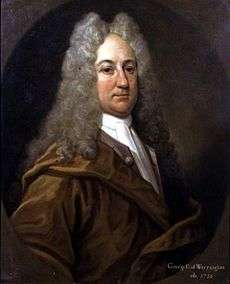George Booth, 2nd Earl of Warrington
| George Booth | |
|---|---|
 Lord Warrington circa 1730 | |
| Born |
2 May 1675 Mere Hall, Cheshire |
| Died |
2 August 1758 (aged 83) Dunham Massey, Cheshire |
| Resting place | Church of St Mary the Virgin, Bowdon |
| Title |
Earl of Warrington, Baron Delamer, Baronet |
| Tenure | 1694 - 1758 |
| Nationality |
|
| Locality | Cheshire |
George Booth, 2nd Earl of Warrington (2 May 1675 – 2 August 1758) was an English peer and landowner, who amassed a fine collection of silver.
Life
Born at Mere Hall, Cheshire on 2 May 1675,[1] the second son of Henry Booth, 1st Earl of Warrington by Mary, daughter of Sir James Langham Bt, of Cottesbrooke, he was known by the courtesy title of Lord Delamer before succeeding to the family titles upon his father's death in 1694.
Apart from being a renowned collector of silver plate, he received the appointment of Lord Lieutenant of Cheshire, another nobleman being nominated to discharge the duties during his minority. [1]
In 1739, he wrote, Considerations upon the Institution of Marriage, with some thoughts concerning the force and obligation of the marriage contract, wherein is considered how far divorces may or may not be allowed, By a Gentleman. Humbly submitted to the judgment of the impartial. It is an argument in favour of divorce on the ground of incompatibility of temper. From other sources we learn that he had been convinced of the advisability of admitting this as a sufficient reason by his own unhappy experiences. Luttrell states that the lady had a fortune of £40,000, and Philip Bliss, in a manuscript note in a copy of Walpole‘s Royal and Noble Authors, now in the British Museum, adds:
Some few years after my lady had consign'd up her whole fortune to pay my lord’s debts, they quarrelled, and lived in the same house as absolute strangers to each other at bed and hoard.
Of the earl and his lady there is an amusing and not too flattering description in a letter by Mrs, Bradshaw, printed in Letters to and from Henrietta, Countess of Suffolk (1824), i. 97:
The Earl and Countess of Warrington, met us, which to me quite spoiled the feast ; she is a limber dirty fool, and he the stiffest of all stiff things.

Besides his pamphlet on divorce the earl was the author of a Letter to the writer of the "Present State of the Republic of Letters", vindicating his father from the reflections against him in Burnet’s History of his own Time.[1]
Lord Warrington died on 2 August 1758, and was buried in the Booth Chapel, the family vault, at Bowdon Church,[1] 3 miles (4.8 km) from Dunham Massey Hall.
Family
In 1702, Lord Warrington married Mary, daughter of Sir John Oldbury, a City merchant, of St Dunstan's in the East, by his wife, Mary Bohun. Mary, Countess of Warrington died in 1740, having given birth to only child. Their daughter and heiress, Lady Mary Booth, married in 1736 Henry Grey, 4th Earl of Stamford, who inherited the estates in Cheshire and Lancashire. [1] Upon his death, the earldom of Warrington became extinct, whilst the other family titles of Baron Delamer and the baronetcy created in 1611, devolved upon his cousin, Nathaniel Booth.
Their only daughter, Lady Mary Booth, became the Countess of Stamford upon marrying Henry Grey, 4th Earl of Stamford, and she inherited all the Booth estates, including Dunham Massey. Their son, George Grey, 5th Earl of Stamford was recreated in 1796 Earl of Warrington in addition to the Stamford title, the family being known as Earls of Stamford and Warrington (until the death in 1905 of the dowager Countess Katharine, widow of George Grey, 7th Earl of Stamford).
See also
References
- Attribution
![]() This article incorporates text from a publication now in the public domain: Henderson, Thomas Finlayson (1886). "Booth, George (1675-1758)". In Stephen, Leslie. Dictionary of National Biography. 5. London: Smith, Elder & Co.
This article incorporates text from a publication now in the public domain: Henderson, Thomas Finlayson (1886). "Booth, George (1675-1758)". In Stephen, Leslie. Dictionary of National Biography. 5. London: Smith, Elder & Co.
Sources
- Collins Peerage
- Burkes Peerage (1970 edition), q.v. Stamford, E
- The BBC - George Booth, 2nd Earl of Warrington, April 16, 2012
- George Booth (1675–1758), 2nd Earl of Warrington, BBC Paintings
- THE ARMS OF BOOTH QUARTERING OTHERS, FOR GEORGE, 2ND EARL OF WARRINGTON (1675-1758), Christie's
External links
| Peerage of England | ||
|---|---|---|
| Preceded by Henry Booth |
Earl of Warrington 1st creation 1694–1758 |
Extinct |
| Baron Delamer 1st creation 1694–1758 |
Succeeded by Nathaniel Booth | |